Wiring and where to put your plug sockets should be one of your first considerations when renovating your home. When I was renovating my place; My plan was just to put as many plug sockets in each room as I could. This worked out ok, but I could have done it better. Hopefully, you’ll be able to learn from my experience of getting it done.
So, how to decide where to put plug sockets in your home?
In the UK, plug sockets have to be at least 400 mm or more off the ground and light switches up to a maximum height of 1200 mm off the ground. Be aware of this before you plan. Map out the practical use of each room including plans for a wall-mounted TV, and where all your furniture will be. Ask your electrician about the maximum number of plug sockets you should have in each room. This will help you to prioritize.
This information was sourced from electricalapprentice.co.uk . My house is fully electric, and it needed completely new wiring throughout. There were basically no plug sockets in the place before I bought it. It’s useful to have an understanding of how your home is supplied with electricity
Understand the basics of electrical Wiring for your plugs in your home

It’s worth having a high-level understanding of how your home is supplied with electricity. Firstly it will help you to understand conversations that you are having with your electrician and secondly, it will help you to make decisions around the configuration of your plug sockets and light switches too.
Electricity is distributed by your fusebox, where your electricity is split into circuits known as radial or ring (more common) circuits servicing the power outlets such as plug sockets. The power supply is usually split into two or three circuits servicing upstairs, downstairs, & your kitchen for example. Light circuits are separate from this. An average home will usually have two light circuits.
This information is useful in understanding whether you need to re-wire your whole home or not. You may for instance need additional plug sockets, but your lighting may be fine. Having this knowledge can save you a ton of money, and now you have it! (I wish I did when I was re-wiring)
Ring Circuit – A power circuit made up of a ring formed from the Fuse Box so that each socket on the loop is connected both ways around the loop back to the Fuse Box.
Radial Circuit – A power circuit starting at the Fuse Box and terminating at the furthest socket or appliance, each socket being connected to the previous one in the circuit. This type of circuit is common with a shower appliance or a cooker.
How do you know if your house needs to be rewired?
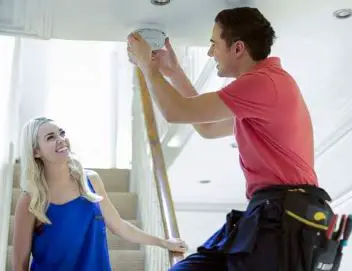
Deciding to re-wire my home was an easy decision. There were only two plug sockets in my living room, and I lost all power at one point. Seriously, I plugged in my wallpaper stripper and lost electricity in the rest of my home. The decision for you may not be obvious though.
Your home may need to be re-wired or need some re-wiring if your wiring is old and you want things like:
- Dimmer light switches
- Additional plug sockets
- An electrical oven or hob
- or if your home is running on one ring circuit (like mine was!)
- If you want a two-way switch. Light switch at the top and bottom of your stairs
I’ve included these items, as they were things that I wanted in my place. Your electrician can help you make these decisions of course; But here’s a few things you can look out for to clue yourself up to make sure you don’t end up getting more electrical work done than you need to.
Here are some things that I learned when getting the things I mentioned above installed in my house.
New Dimmer Switches like this one (link to Amazon) require a ground wire to function. If your house is old and you don’t have an ‘earth’ wire, and you really want a dimmer switch, this is a definite tick in the “get your lights re-wired” side of your list.
You may not need to re-wire your whole house as plugs and lights tend to be wired separately.
Additional Plug sockets like these (link to Amazon) are pretty standard. If you want them, you will need some re-wiring. One ring circuit can only cover up to 100 meters, but you can have as many plug sockets as you want.
Make sure you confirm the placement of your plug sockets with your electrician. You may not be able to put a plug socket certain regions of your house if’ a difficult position to spur off another plug socket for example.
An Electrical Oven or Hob – Usually you will separate cables per appliance to be run from your fuse box to your kitchen. In terms of the cable size, check your appliance manual, but in most cases, a 6 mm T&E (twin and earth) cable and a 32 amp fuse should be fine.
Your home is running off one ring circuit – It’s unlikely that you will have this issue, however, my home was running from one ring by the previous owner. This included the kitchen, bathroom, bedrooms and living rooms.
You want a two way switch – A light switch at the top and the bottom of the stairs for example requires a two way switch. If you don’t already have this, but additional wiring will be required.
You can check to see if you have this issue when looking at your fuse box, specifically looking at your circuit breakers which, we’ll go into below.
Understanding Your Fuse Box
Before you call your electrician just take a look at your fuse box and get familiar with it. Your fuse box for example to tell you how many circuits you’ve got in your home. Here’s a picture of my fuse box, which I’ll briefly go through.
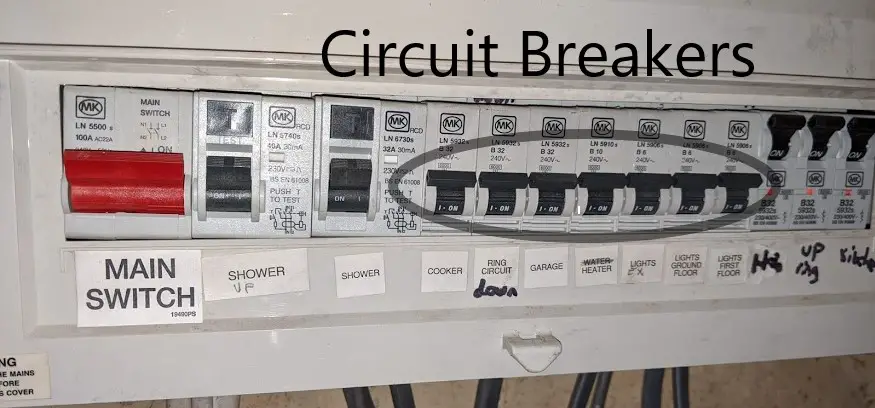
- The Main Switch: The main switch, as you probably will have guessed it allows you to switch off your entire home’s electrical supply. You may need it if your changing plug sockets by hand for example.
- Circuit Breakers: Circuit breaks cover the individual circuits you will have in your house. If you’re looking at it for the first time, you can use it as a guide to see how many circuits you have in your home. If electrics are not working in a region of your house, you can try and identify where the fault is looking at this.
Main switches or circuit breakers are designed to ‘trip’ . Whenever your fuse box detects any abnormalities in the amount of electricity being pulled it’s designed to switch off the power supply to that given area. This could be because of of an over loaded plug socket or a fault electrical item. Usually it’s a process of elimination to identify the ‘culprit’.
How do you tell if the wiring in your house is bad?
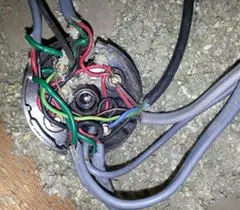
Identifying if your wiring is bad in your home can be a tricky exercise, and just jumping on the phone and getting your electrician to re-wire your home may not be necessary. If your budget is particularly tight (like mine was) then it’s really useful to know what electrical work actually needs doing.
So how can you tell if the wiring in your house is bad?
- Check if your circuit breakers keep tripping, if they do, this is a sign of faulty wiring.
- See if your lights keep flickering and listen out for any buzzing or dimming.
- look at the height of your plug sockets. If they are as low as your skirting boards, this will not comply with current standards
- If your plug sockets feel warm when used, this can also be a sign of bad wiring.
Getting your wiring replaced may not be needed, but it might be worth doing, if your wiring is particularly old. Its a task best done before you renovate the rest of your home.
How Many Plug/Wall Sockets Should I have Per Room?
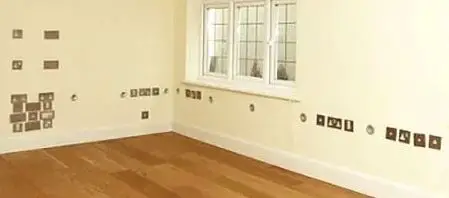
There is no restriction on the number of plug/wall sockets that you can have in a particular room. You are limited to the length of each circuit which is 100m2 for any given room.
It does come down to general preference when deciding how many plug sockets you should have in each room.
As a general guide – Here’s the number of plug sockets in your home, but there’s a more detailed table below:
- Living Room – 6 double sockets should be a minimum (TV, Router, Lamps, spare sockets for laptops and charges)
- Bedroom – 4-6 double sockets in each bedroom. (Bedside table lamps, charger points, Points for hairdryers, and television)
- Dining Room – 4- 6 double sockets for lamps, laptops as well if you use this room for other purposes too.
- Outdoor double socket electrical point – Often overlooked, but a useful point for a lawnmower, jetwash, or other garden appliance outdoors.
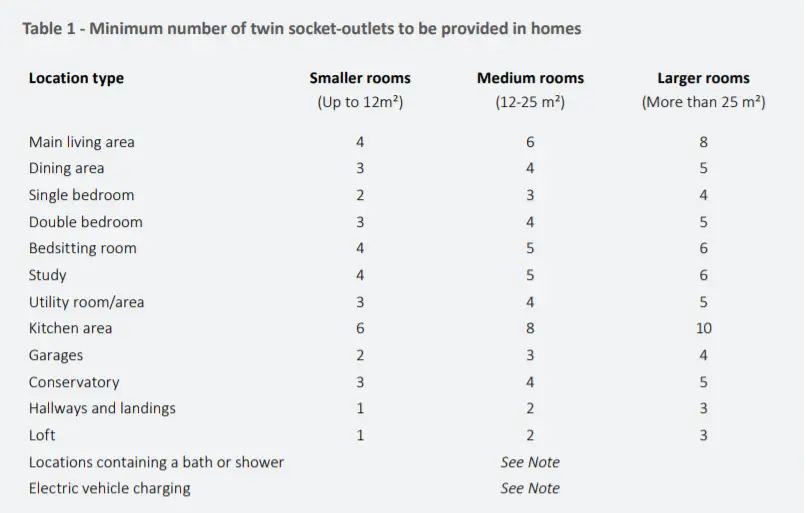
The table above was taken from this guide published by electricalsafetyfirst.org and can give you more detailed guidelines according to room size etc. Placement is arguably more important. If you are mounting a TV on a wall for example, then you should think about placement on the wall as ideally, you don’t want any exposed wires. Symmetry is a thing for me too.
You only get your plug sockets done once, so if you have a square room, placing your plugs parallel to each other and the same distance away from of wall in terms of height and length looks better.
When a plug socket is taken from the circuit, the term used is to ‘spur’ off. You can only have one socket per spur off the circuit. In case you’re wondering, the number of plug sockets you have on a circuit will not affect your supply of electricity to any of your sockets.
How Many Sockets Should a Kitchen Have?

Any electrical cookers or ovens should be wired directly into your fusebox. You will however need separate cooker and oven switches.
Around 6 double plug sockets in addition to appliances directly wired into your fuse box is a good amount to have in your kitchen.
Other appliances such as your washing machine, dishwasher, or tumble dryer can be connected via plug sockets.
It’s useful to have multiple plug sockets in your kitchen for your various cooking gadgets, just be careful with the proximity to running water and check with an electrician that your placement is okay.
What type of plug socket should I buy? Are they all the same size?
In my experience, plug sockets are generally the same size, but choosing whether you buy falt plug socket plates or moulded ones that stickout slightly depend on whther your plugs can sit flush in your wall. This will depend on the quality of theplastering and how well the electrician fitted the back panel of the plug socket.
This is what mine looks like.
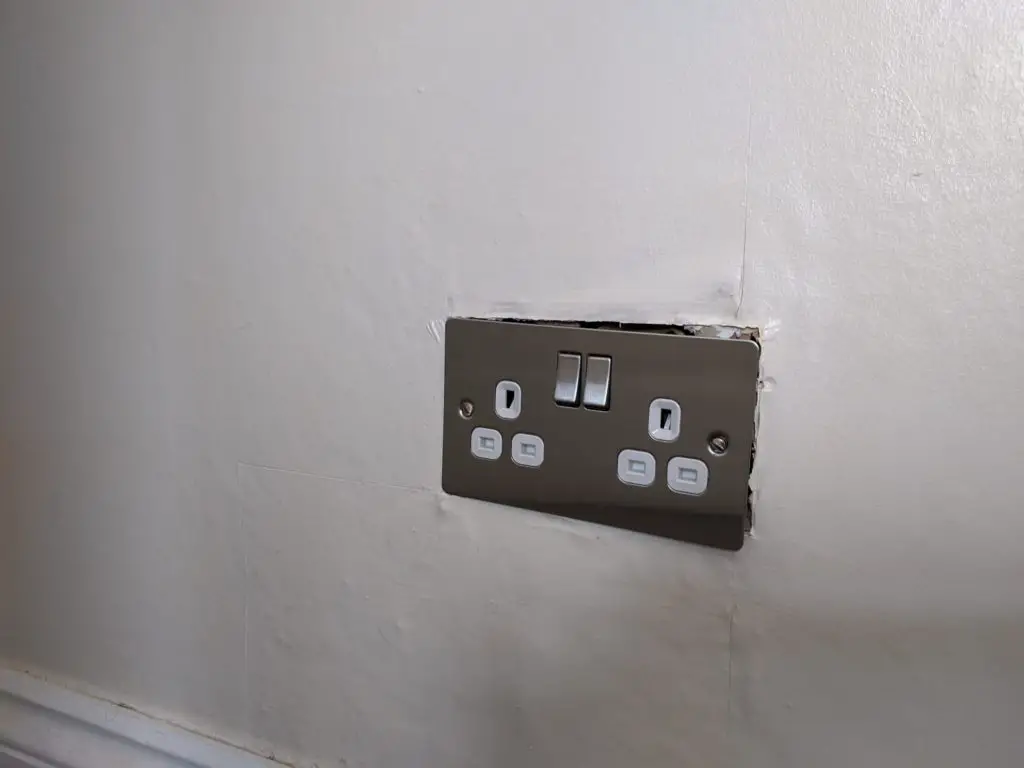
I’ve taken a picture of the worst plug socket in my house to show you how bad it can get. I probably should have bought molded plates, to be honest.
If do not have clean edges, of the plug socket casing, sticks out a little, you are better off buying a molded plug socket cover.
Are USB sockets any good?

Everything is charged by USB nowadays. In fact, I find that I have tobuy seperate plug adapters for most things, including my phone just to charge it.
USB sockets are a good way to avoid the need for an adaptor at home for your phone or other digital devices, but make sure you get the right one.
Look to purchase USB sockets that share a minimum of 3.1 amps, they are hard to find, but they are worth seeking out if you want quick charging on multiple devices.
The most importnt consideration when looking at USB sockets is the Amps that can be supplied from them. This is usually displayed on the plug socket plate. The higher the amps, the more powerful the electrical flow is.
Another important point is that the amperage of USB sockets is usually shared between the two ports, so if you have two devices charging, effectively it will take longer to charge.
Try and buy sockets with dedicated 1.0 and 2.1 amp sockets to make sure you get consistent charging speeds across your devices.
You need to get good USB sockets if you arebuying them, as many popular devices like iPads require a minimum flow of 2.1 Amps. If you buy a USB socket that delivers electricity at 1-2 Amps for example, your iPad will charge, but extremely slowly.
You will end up just using your adaptor, which kind of defeats the point of buying one in the first place.
How disruptive is rewiring a house?
Rewiring a house is one of the most disruptive activities when renovating your house. Because of this, it’s preferable to get this job done first ideally.
Most if not all activities should be done after re-wiring a house
Your electrician may need to fit a new fuse box and then run new cables under floor boards, which means pulling up existing floors which is frustrating if you’ve just furnished.
Be prepared for channels for your plug sockets and cables to be dug into your walls as well. It’s not advisable to have your plastering done before electrical work either.
In Summary…
Deciding where to put your plug sockets is a bigger job than it seems. It can lead to a lot of re-wiring in your home, and it’s good to find out that you need to do this as soon as you can in your renivation project.
Rewiring your home is a disruptive activity, and understanding how electric circuits work at a high level can help you to make important decisions concerning plug socket placement, light switches and electric appliances such as an electrical hob and oven.
Having some understanding about your current set up can also help you avoid unnecessary electrical work advised by your electrician too, so hopefully, my experience has helped you on your way.
If you enjoyed this article, feel free to check out some more of my content here. If you have some other home renovation or DIY questions, maybe I can help.

